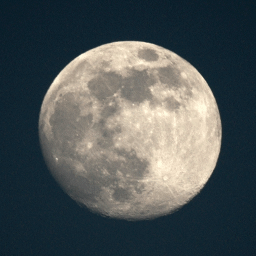« Reading List: X-15 Photo Scrapbook |
Main
| Well, that'll have to do... »
Monday, January 24, 2005
Moon near Apogee, Earth near Perihelion
In July 2004 I posted
Moon near Perigee, Earth near Aphelion, which compares two images taken
within 24 hours showing the full Moon near perigee and the Sun from the Earth near aphelion. In that document I said that, weather
permitting, I hoped to shoot the converse case: full Moon near apogee and Earth close to perihelion in December 2004. Well, the weather
 Click image to view enlargement.
Click image to view enlargement.
|
didn't co-operate, but I still held out hope for the end of January. This isn't quite as close to perihelion (which occurred on January 2nd at 00:37 UTC) but it'll do: on January 23rd the Earth is about 156,000 kilometres from perihelion, only 3% of the distance from perihelion to aphelion. The difference in apparent size of the Sun is barely perceptible.
Given that it has snowed for the last five days, the weather didn't look all that promising in the run-up to the January 23rd apogean near-full Moon. But then, right before sunset on Sunday the 23rd, the Sun emerged from between the clouds. I grabbed the tripod on which I'd already mounted the Nikon 500mm f/8 mirror lens with full-aperture Orion solar filter and D70 digital camera body to be ready for such opportunities, dashed outside, planted it in the snow, and took a bunch of shots at various shutter speeds. With the
Sun only 4° above the horizon, the seeing was less than ideal, but two sunspot groups were clearly visible (and handy for focusing). Well, turbulent skies sure beat a kilometre-thick cloud deck from which snow is sifting down. We're amateur astronomers; we make the best of what we get!
After shooting the Sun, I turned to the Moon, which was rising in a pellucid sky in the East. While the Moon won't be full until 10:33 UTC on January 25th, it was already 97% full, and only three hours before perigee (18:55 UTC). I whipped off the solar filter, centred the Moon, and shot a sequence of exposures at various shutter speeds. In both the Sun and Moon photos, I used the D70's self-timer to trip the shutter to minimise vibration. I'd have preferred to use an ML-L3 infrared remote, but that gizmo appears to be fabricated from unobtanium bar stock--I've had one on back-order for more than six months--so the self-timer will have to serve in its absence.
Details . . . you want details. OK: the Sun was photographed at 15:48 UTC on 2005-01-23 at 1/80 second with the CCD sensitivity set to ISO 200. The Moon shot was taken at 15:55 through the same f/8 500mm mirror lens
sans solar filter at 1/500 second. The images were cropped and contrast stretched, but not otherwise manipulated, then assembled into a GIF animation with Jasc Animation Shop. The sunspot near the centre of the solar disc is NOAA Active Region 0726; the one near the solar limb is Active Region 0725.
With the blink comparison between Sun and Moon, the difference in angular extent is obvious. Note how this image compares with the
converse configuration almost seven months ago.
Posted at January 24, 2005 01:17
